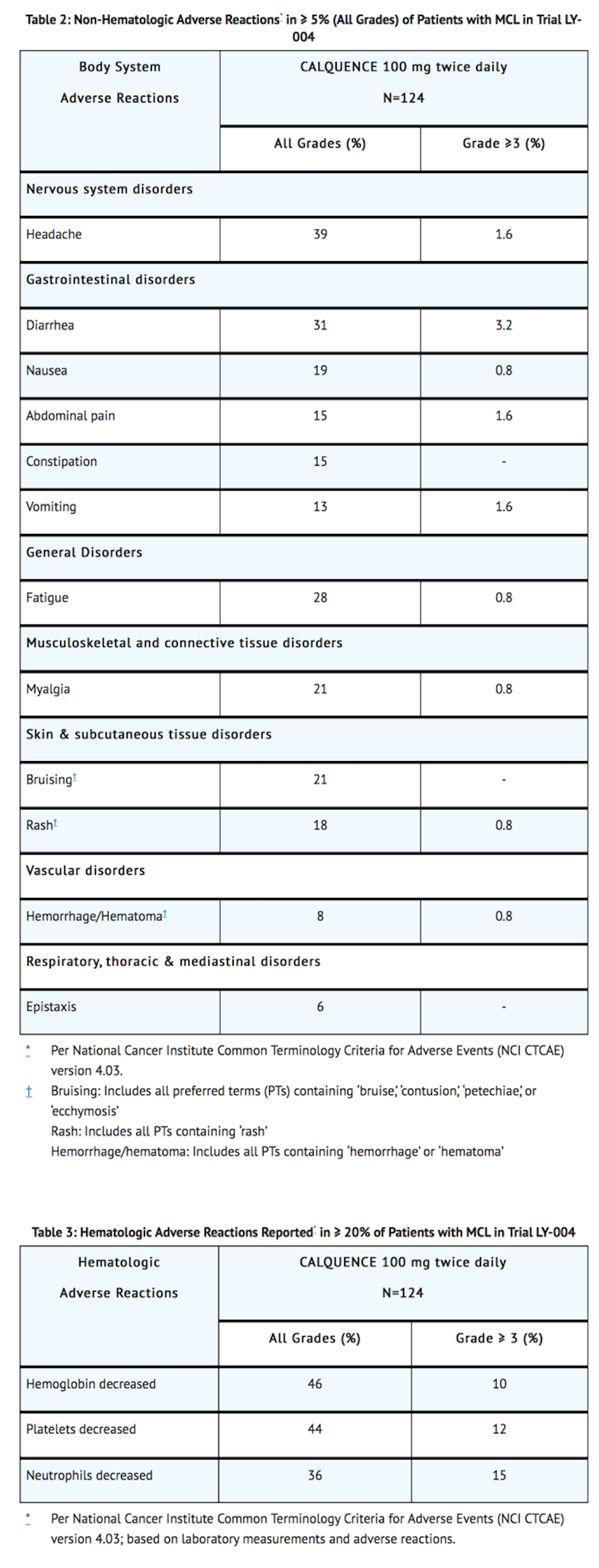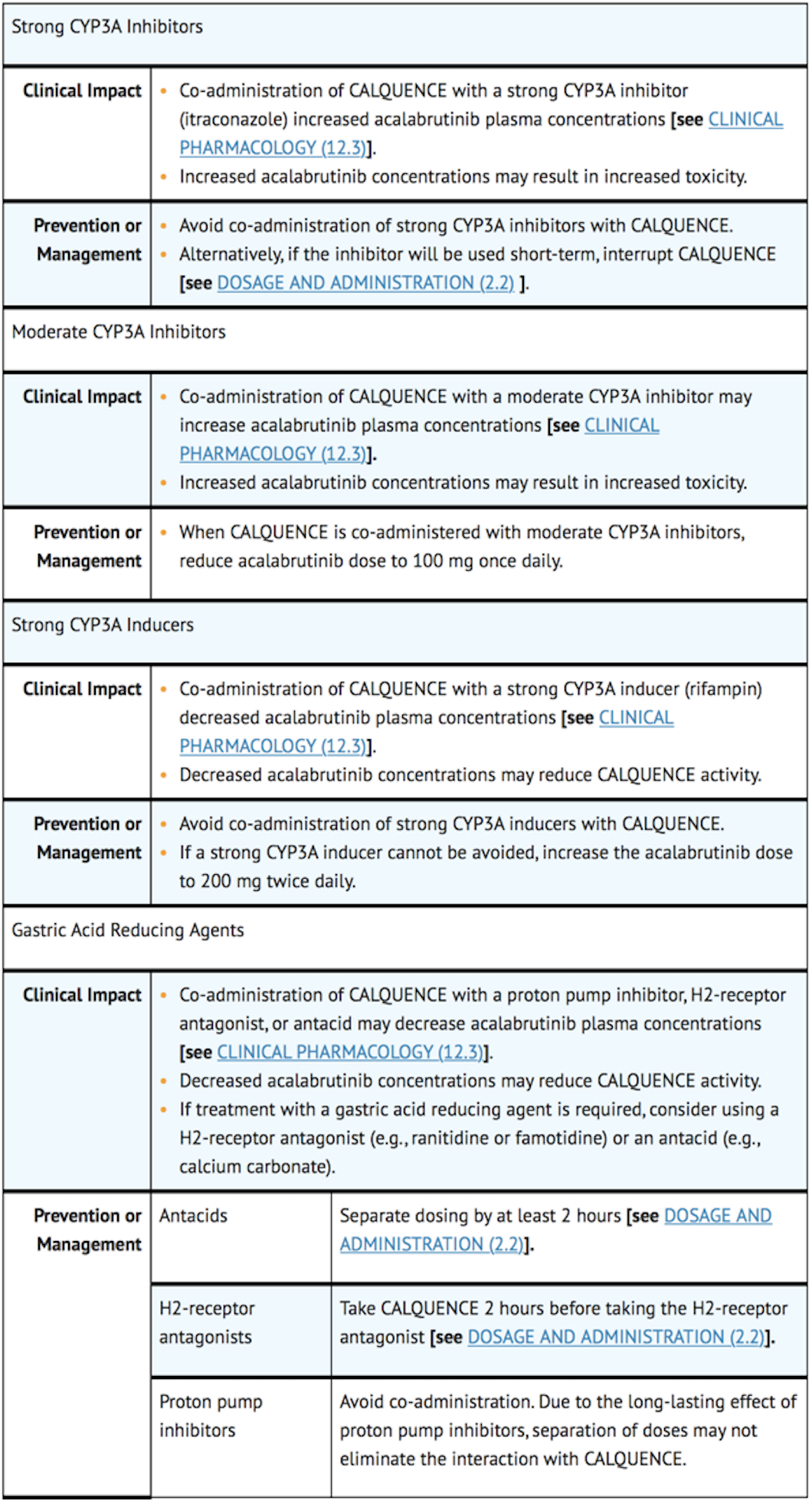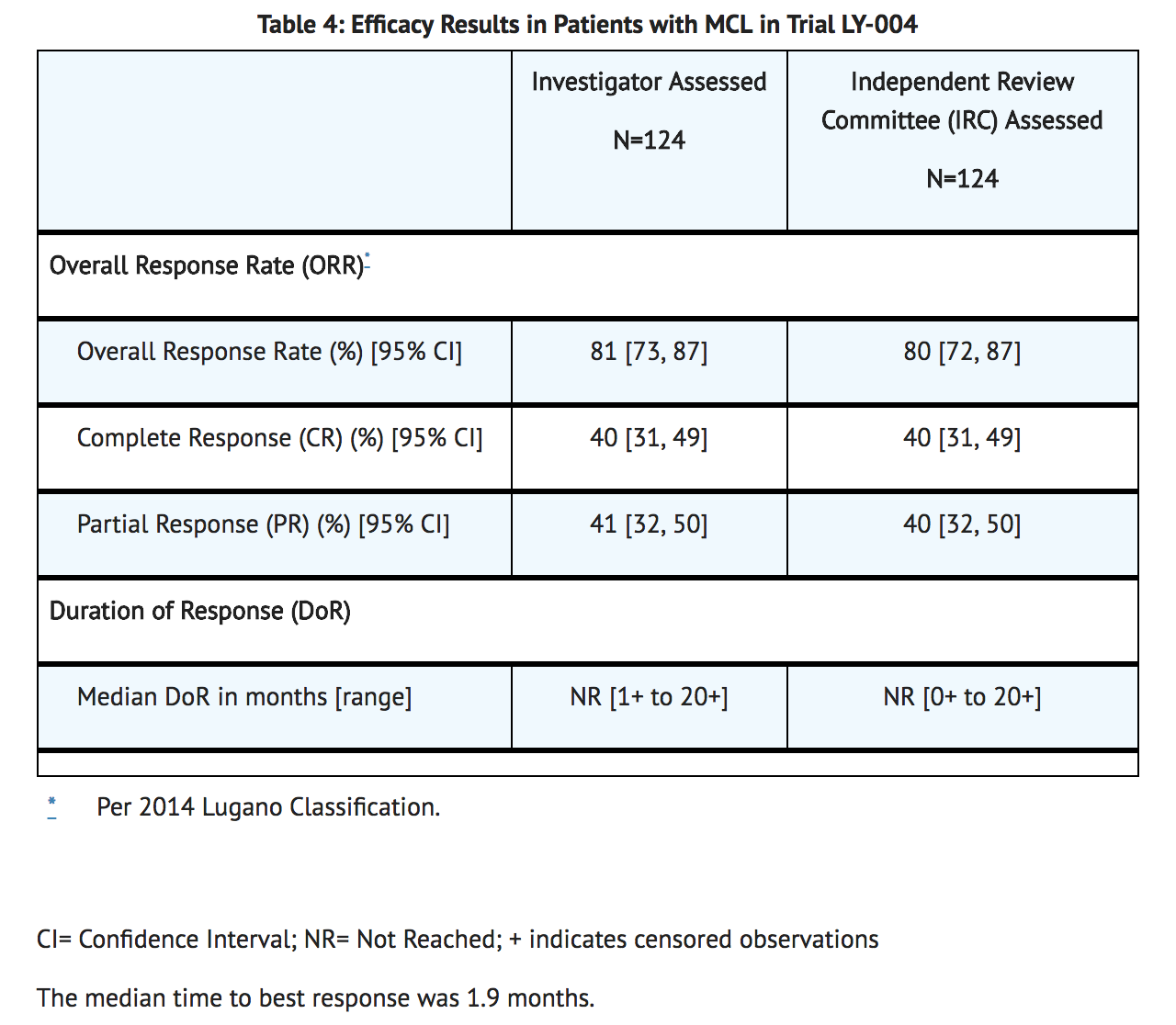Acalabrutinib: Difference between revisions
No edit summary |
No edit summary |
||
| Line 17: | Line 17: | ||
[[image:Acalabrutinib_Dose_Modifications.png|none|thumb|400px|This image is provided by the National Library of Medicine.]] | [[image:Acalabrutinib_Dose_Modifications.png|none|thumb|400px|This image is provided by the National Library of Medicine.]] | ||
|offLabelAdultGuideSupport | |offLabelAdultGuideSupport= | ||
* | *There is limited information regarding Acalabrutinib Off-Label Guideline-Supported Use and Dosage (Adults) in the drug label. | ||
|offLabelAdultNoGuideSupport= | |||
* | *There is limited information regarding Acalabrutinib Off-Label Non-Guideline-Supported Use and Dosage (Adults) in the drug label. | ||
|fdaLIADPed= | |fdaLIADPed= | ||
Revision as of 02:17, 18 June 2018
Editor-In-Chief: C. Michael Gibson, M.S., M.D. [1]; Associate Editor(s)-in-Chief: Yashasvi Aryaputra[2];
Disclaimer
WikiDoc MAKES NO GUARANTEE OF VALIDITY. WikiDoc is not a professional health care provider, nor is it a suitable replacement for a licensed healthcare provider. WikiDoc is intended to be an educational tool, not a tool for any form of healthcare delivery. The educational content on WikiDoc drug pages is based upon the FDA package insert, National Library of Medicine content and practice guidelines / consensus statements. WikiDoc does not promote the administration of any medication or device that is not consistent with its labeling. Please read our full disclaimer here.
Overview
Acalabrutinib is a kinase inhibitor that is FDA approved for the the treatment of mantle cell lymphoma (MCL). Common adverse reactions include anemia, thrombocytopenia, headache, neutropenia, diarrhea, fatigue, myalgia, and bruising.
Adult Indications and Dosage
FDA-Labeled Indications and Dosage (Adult)
Indications:
- CALQUENCE is indicated for the treatment of adult patients with mantle cell lymphoma (MCL) who have received at least one prior therapy.
- This indication is approved under accelerated approval based on overall response rate. Continued approval for this indication may be contingent upon verification and description of clinical benefit in confirmatory trials.
Dose Modifications

Off-Label Use and Dosage (Adult)
Guideline-Supported Use
- There is limited information regarding Acalabrutinib Off-Label Guideline-Supported Use and Dosage (Adults) in the drug label.
Non–Guideline-Supported Use
- There is limited information regarding Acalabrutinib Off-Label Non-Guideline-Supported Use and Dosage (Adults) in the drug label.
Pediatric Indications and Dosage
FDA-Labeled Indications and Dosage (Pediatric)
There is limited information regarding Acalabrutinib FDA-Labeled Indications and Dosage (Pediatric) in the drug label.
Off-Label Use and Dosage (Pediatric)
Guideline-Supported Use
There is limited information regarding Acalabrutinib Off-Label Guideline-Supported Use and Dosage (Pediatrics) in the drug label.
Non–Guideline-Supported Use
There is limited information regarding Acalabrutinib Off-Label Non-Guideline-Supported Use and Dosage (Pediatrics) in the drug label.
Contraindications
- None
Warnings
Hemorrhage
- Serious hemorrhagic events, including fatal events, have occurred in the combined safety database of 612 patients with hematologic malignancies treated with CALQUENCE monotherapy. Grade 3 or higher bleeding events, including gastrointestinal, intracranial, and epistaxis have been reported in 2% of patients. Overall, bleeding events including bruising and petechiae of any grade occurred in approximately 50% of patients with hematological malignancies.
- The mechanism for the bleeding events is not well understood. CALQUENCE may further increase the risk of hemorrhage in patients receiving antiplatelet or anticoagulant therapies and patients should be monitored for signs of bleeding. Consider the benefit-risk of withholding CALQUENCE for 3-7 days pre- and post-surgery depending upon the type of surgery and the risk of bleeding.
Infection
- Serious infections (bacterial, viral or fungal), including fatal events and opportunistic infections have occurred in the combined safety database of 612 patients with hematologic malignancies treated with CALQUENCE monotherapy. Consider prophylaxis in patients who are at increased risk for opportunistic infections.
- Grade 3 or higher infections occurred in 18% of these patients. The most frequently reported Grade 3 or 4 infection was pneumonia. Infections due to hepatitis B virus (HBV) reactivation and progressive multifocal leukoencephalopathy (PML) have occurred. Monitor patients for signs and symptoms of infection and treat as medically appropriate.
Cytopenias
- In the combined safety database of 612 patients with hematologic malignancies, patients treated with CALQUENCE monotherapy experienced Grade 3 or 4 cytopenias, including neutropenia (23%), anemia (11%) and thrombocytopenia (8%) based on laboratory measurements. In the CALQUENCE clinical Trial LY-004, patients’ complete blood counts were assessed monthly during treatment.
Second Primary Malignancies
- Second primary malignancies, including non-skin carcinomas, have occurred in 11% of patients with hematologic malignancies treated with CALQUENCE monotherapy in the combined safety database of 612 patients. The most frequent second primary malignancy was skin cancer, reported in 7% of patients. Advise protection from sun exposure.
Atrial Fibrillation and Flutter
- In the combined safety database of 612 patients with hematologic malignancies treated with CALQUENCE monotherapy, atrial fibrillation and atrial flutter of any grade occurred in 3% of patients, and Grade 3 in 1% of patients. Monitor for atrial fibrillation and atrial flutter and manage as appropriate.
Adverse Reactions
Clinical Trials Experience
- As clinical trials are conducted under widely varying conditions, adverse reaction rates observed in the clinical trials of a drug cannot be directly compared to rates in the clinical trials of another drug and may not reflect the rates observed in practice.
- The safety data described in this section reflect exposure to CALQUENCE (100 mg twice daily) in 124 patients with previously treated MCL in Trial LY-004. The median duration of treatment with CALQUENCE was 16.6 (range 0.1 to 26.6) months. A total of 91 (73.4%) patients were treated with CALQUENCE for ≥ 6 months and 74 (59.7%) patients were treated for ≥ 1 year.
- The most common adverse reactions (≥ 20%) of any grade were anemia, thrombocytopenia, headache, neutropenia, diarrhea, fatigue, myalgia, and bruising. Grade 1 severity for the non-hematologic, most common events were as follows: headache (25%), diarrhea (16%), fatigue (20%), myalgia (15%), and bruising (19%). The most common Grade ≥ 3 non-hematological adverse reaction (reported in at least 2% of patients) was diarrhea.
- Dose reductions or discontinuation due to any adverse reaction were reported in 1.6% and 6.5% of patients, respectively.

- Increases in creatinine 1.5 to 3 times the upper limit of normal occurred in 4.8% of patients.
Postmarketing Experience
There is limited information regarding Acalabrutinib Postmarketing Experience in the drug label.
Drug Interactions

Use in Specific Populations
Pregnancy
- Risk Summary
- Based on findings in animals, CALQUENCE may cause fetal harm when administered to a pregnant woman. There are no available data in pregnant women to inform the drug-associated risk. In animal reproduction studies, administration of Acalabrutinib to pregnant rabbits during organogenesis resulted in reduced fetal growth at maternal exposures (AUC) approximately 4 times exposures in patients at the recommended dose of 100 mg twice daily (see Data). Advise pregnant women of the potential risk to a fetus.
- The estimated background risk of major birth defects and miscarriage for the indicated population is unknown. All pregnancies have a background risk of birth defect, loss, or other adverse outcomes. In the U.S. general population, the estimated background risk of major birth defects and miscarriage in clinically recognized pregnancies is 2-4% and 15-20%, respectively.
- Data (Animal Data)
- In a combined fertility and embryo-fetal development study in female rats, Acalabrutinib was administered orally at doses up to 200 mg/kg/day starting 14 days prior to mating through gestational day [GD] 17. No effects on embryo-fetal development and survival were observed. The AUC at 200 mg/kg/day in pregnant rats was approximately 16-times the AUC in patients at the recommended dose of 100 mg twice daily. The presence of Acalabrutinib and its active metabolite were confirmed in fetal rat plasma.
- In an embryo-fetal development study in rabbits, pregnant animals were administered Acalabrutinib orally at doses up to 200 mg/kg/day during the period of organogenesis (from GD 6-18). Administration of Acalabrutinib at doses ≥ 100 mg/kg/day produced maternal toxicity and 100 mg/kg/day resulted in decreased fetal body weights and delayed skeletal ossification. The AUC at 100 mg/kg/day in pregnant rabbits was approximately 4-times the AUC in patients at 100 mg twice daily.
Pregnancy Category (AUS):
There is no Australian Drug Evaluation Committee (ADEC) guidance on usage of Acalabrutinib in women who are pregnant.
Labor and Delivery
There is no FDA guidance on use of Acalabrutinib during labor and delivery.
Nursing Mothers
- No data are available regarding the presence of Acalabrutinib or its active metabolite in human milk, its effects on the breastfed child, or on milk production. Acalabrutinib and its active metabolite were present in the milk of lactating rats. Due to the potential for adverse reactions in a breastfed child from CALQUENCE, advise lactating women not to breastfeed while taking CALQUENCE and for at least 2 weeks after the final dose.
Pediatric Use
- The safety and efficacy of CALQUENCE in pediatric patients have not been established.
Geriatic Use
- Eighty (64.5%) of the 124 MCL patients in clinical trials of CALQUENCE were 65 years of age or older, and 32 patients (25.8%) were 75 years of age or older. No clinically relevant differences in safety or efficacy were observed between patients ≥ 65 years and younger.
Gender
There is no FDA guidance on the use of Acalabrutinib with respect to specific gender populations.
Race
There is no FDA guidance on the use of Acalabrutinib with respect to specific racial populations.
Renal Impairment
There is no FDA guidance on the use of Acalabrutinib in patients with renal impairment.
Hepatic Impairment
There is no FDA guidance on the use of Acalabrutinib in patients with hepatic impairment.
Females of Reproductive Potential and Males
There is no FDA guidance on the use of Acalabrutinib in women of reproductive potentials and males.
Immunocompromised Patients
There is no FDA guidance one the use of Acalabrutinib in patients who are immunocompromised.
Administration and Monitoring
Administration
- The recommended dose of CALQUENCE is 100 mg taken orally approximately every twelve hours until disease progression or unacceptable toxicity.
- Advise patients to swallow capsule whole with water. Advise patients not to open, break or chew the capsules. CALQUENCE may be taken with or without food. If a dose of CALQUENCE is missed by more than 3 hours, it should be skipped and the next dose should be taken at its regularly scheduled time. Extra capsules of CALQUENCE should not be taken to make up for a missed dose.
Monitoring
There is limited information regarding Acalabrutinib Monitoring in the drug label.
IV Compatibility
There is limited information regarding the compatibility of Acalabrutinib and IV administrations.
Overdosage
There is limited information regarding Acalabrutinib overdosage. If you suspect drug poisoning or overdose, please contact the National Poison Help hotline (1-800-222-1222) immediately.
Pharmacology
Acalabrutinib
| |
| Systematic (IUPAC) name | |
| ? | |
| Identifiers | |
| CAS number | ? |
| ATC code | ? |
| PubChem | ? |
| Chemical data | |
| Formula | ? |
| Mol. mass | ? |
| Pharmacokinetic data | |
| Bioavailability | ? |
| Metabolism | ? |
| Half life | ? |
| Excretion | ? |
| Therapeutic considerations | |
| Pregnancy cat. |
? |
| Legal status | |
| Routes | ? |
Mechanism of Action
(Description)
Structure
(Description with picture)
Pharmacodynamics
(Description)
Pharmacokinetics
(Description)
Nonclinical Toxicology
(Description)
Clinical Studies
- The efficacy of CALQUENCE was based upon Trial LY-004 titled “An Open-label, Phase 2 Study of ACP-196 in Subjects with Mantle Cell Lymphoma” (NCT02213926). Trial LY-004 enrolled a total of 124 patients with MCL who had received at least one prior therapy.
- The median age was 68 (range 42 to 90) years, 80% were male, and 74% were Caucasian. At baseline, 93% of patients had an ECOG performance status of 0 or 1. The median time since diagnosis was 46.3 months and the median number of prior treatments was 2 (range 1 to 5), including 18% with prior stem cell transplant. Patients who received prior treatment with BTK inhibitors were excluded. The most common prior regimens were CHOP-based (52%) and ARA-C (34%). At baseline, 37% of patients had at least one tumor with a longest diameter ≥ 5 cm, 73% had extra nodal involvement including 51% with bone marrow involvement. The simplified MIPI score (which includes age, ECOG score, and baseline lactate dehydrogenase and white cell count) was intermediate in 44% and high in 17% of patients.
- CALQUENCE was administered orally at 100 mg twice daily until disease progression or unacceptable toxicity. The median dose intensity was 98.5%. Tumor response was assessed according to the Lugano Classification for Non-Hodgkin’s lymphoma (NHL). The major efficacy outcome of Trial LY-004 was overall response rate (ORR) and the median follow-up was 15.2 months.

Lymphocytosis
- Upon initiation of CALQUENCE, a temporary increase in lymphocyte counts (defined as absolute lymphocyte count (ALC) increased ≥ 50% from baseline and a post baseline assessment ≥ 5 x 109) in 31.5% of patients in Trial LY-004. The median time to onset of lymphocytosis was 1.1 weeks and the median duration of lymphocytosis was 6.7 weeks.
How Supplied

Storage
- Store at 20°C-25°C (68°F-77°F); excursions permitted to 15°C-30°C (59°F- 86°F).
Images
Drug Images
{{#ask: Page Name::Acalabrutinib |?Pill Name |?Drug Name |?Pill Ingred |?Pill Imprint |?Pill Dosage |?Pill Color |?Pill Shape |?Pill Size (mm) |?Pill Scoring |?NDC |?Drug Author |format=template |template=DrugPageImages |mainlabel=- |sort=Pill Name }}
Package and Label Display Panel
{{#ask: Label Page::Acalabrutinib |?Label Name |format=template |template=DrugLabelImages |mainlabel=- |sort=Label Page }}
Patient Counseling Information

Precautions with Alcohol
Alcohol-Acalabrutinib interaction has not been established. Talk to your doctor regarding the effects of taking alcohol with this medication.
Brand Names
There is limited information regarding Acalabrutinib Brand Names in the drug label.
Look-Alike Drug Names
There is limited information regarding Acalabrutinib Look-Alike Drug Names in the drug label.
Drug Shortage Status
Drug Shortage
Price
References
The contents of this FDA label are provided by the National Library of Medicine.